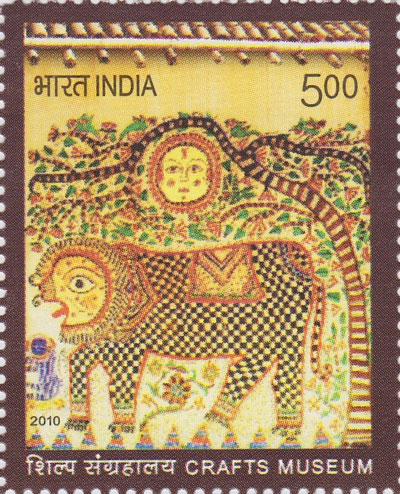The Bengal tiger, or Royal Bengal tiger (Panthera tigris tigris), is a subspecies of tiger native to India, Bangladesh, Nepal and Bhutan. The Bengal tiger is the most numerous of the tiger subspecies — with populations estimated at 1,411 in India, 200 in Bangladesh, 155 in Nepal and 67–81 in Bhutan.
The Bengal tiger has been a national symbol of India since about the 25th century BCE when it was displayed on the Pashupati seal of the Indus Valley Civilisation.The tiger was later the symbol of the Chola Empire from 300 CE to 1279 CE and is now designated as the official animal of India.
The most significant immediate threat to the existence of wild tiger populations is the illegal trade in poached skins and body parts between India, Nepal and China.
Source: Flora – Fauna on stamps: Animals of India–Indipex 2011
Address : https://florafaunaonstamp.blogspot.com/2011/02/animals-of-indiaindipex-2011.html
Date Visited: 15 April 2022
National Animal
The magnificent tiger, Panthera tigris is a striped animal. It has a thick yellow coat of fur with dark stripes. The combination of grace, strength, agility and enormous power has earned the tiger its pride of place as the national animal of India. Out of eight races of the species known, the Indian race, the Royal Bengal Tiger, is found throughout the country except in the north-western region and also in the neighbouring countries, Nepal, Bhutan and Bangladesh. To check the dwindling population of tigers in India, ‘Project Tiger’ was launched in April 1973. So far, 27 tiger reserves have been established in the country under this project, covering an area of 37,761 sq km.
Source: National Animal – National Symbols – Know India: National Portal of India
Address : https://india.gov.in/knowindia/national_animal.php
Date Visited: Sat Sep 03 2011 14:39:02 GMT+0200 (CEST)
A total of 18 tiger range States, distributed in five landscapes of the country would be benefitted under the Project Tiger scheme. […] The schemes would address the human wildlife conflict effectively. […] It will generate direct employment of about 30 lakh mandays annually which shall include many local tribes besides non-tribal local workforce.
Sourece: Government of India’s Umbrella Scheme of Integrated Development of Wildlife Habitats beyond 12th Plan (Press Information Bureau, 5 September 2018)
URL: https://pib.gov.in/Pressreleaseshare.aspx?PRID=1545068
Date Visited: 19 July 2020

wildlife tourism and conservation policies >>
When your neighbour is a tiger | People’s Archive of Rural India
People living near or within the forest in the Bandipur National Park and the Sundarbans revere as well as fear the tiger. Their proximity to tigers, leopards, crocodiles and other big animals often causes violent confrontations, but it has also inspired myths and conservation. Here are PARI’s tales from tiger territory >>
Find up-to-date information provided by, for and about Indian authors, researchers, officials, and educators
List of web portals covered by the present Custom search engine
Action for Community Organisation, Rehabilitation and Development (ACCORD) – www.accordweb.in
Ashoka Trust for Research in Ecology and the Environment (ATREE) – www.atree.org
Freedom United – www.freedomunited.org
Government of India (all websites ending on “.gov.in”)
Shodhganga (a reservoir of Indian theses) – https://shodhganga.inflibnet.ac.in
Survival International – www.survivalinternational.org
Unesco – https://en.unesco.org
Unesco digital library – https://unesdoc.unesco.org
Unicef – www.unicef.org
United Nations – www.un.org/en
Video Volunteers – www.videovolunteers.org
To search Indian periodicals, magazines, web portals and other sources safely, click here. To find publishing details for Shodhganga’s PhD search results, click here >>
Search tips
Combine the name of any particular state, language or region with that of any tribal (Adivasi) community.
Add keywords of special interest (health, nutrition endangered language, illegal mining, sacred grove); learn about the rights of Scheduled Tribes such as the “Forest Rights Act” (FRA); and the United Nations “Declaration on the Rights of Indigenous Peoples”, “Universal Declaration of Human Rights”, “women’s rights”, or “children’s right to education”.
Specify any other issue or news item you want to learn more about (biodiversity, bonded labour and human trafficking, climate change, ecology, economic development, ethnobotany, ethnomedicine, global warming, Himalayan tribe, hunter-gatherers in a particular region or state, prevention of rural poverty, water access).
For official figures include “scheduled tribe ST” along with a union state or region: e.g. “Chhattisgarh ST community”, “Scheduled tribe Tamil Nadu census”, “ST Kerala census”, “Particularly Vulnerable Tribal Group Jharkhand”, “PVTG Rajasthan”, “Adivasi ST Kerala”, “Adibasi ST West Bengal” etc.
In case the Google Custom Search window is not displayed here try the following: (1) toggle between “Reader” and regular viewing; (2) in your browser’s Security settings select “Enable JavaScript” | More tips >>
See also
Accordweb.in | Accord | Articles by co-founder Mari Marcel Thekaekara | Shola Trust
Atree.org | Ashoka Trust for Research in Ecology & the Environment (posts)
Climate change | Audio | The Climate Question (BBC Podcast)
Environmental history and what makes for a civilization – Romila Thapar
Equations blog (Equitable Tourism Options)
Information provided by Indian government agencies and other organizations (FAQ)
Nature and wildlife | Crocodile | Elephant | Tiger | Mangrove forest | Trees
PARI’s tales from tiger territory | People’s Archive of Rural India (PARI)
United Nations on climate change
What is the Forest Rights Act about?
Who is a forest dweller under this law, and who gets rights?
